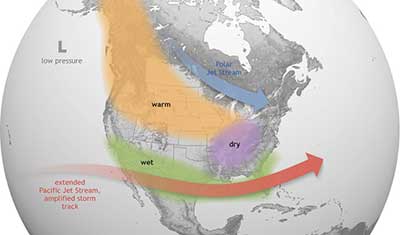Date: 21/03/2023
Relevance: GS-1: Important Geophysical Phenomena such as earthquakes, tsunamis, Volcanic activity, cyclones etc., geographical features and their location; El Nino and La Nina.
Relevance: GS-3: Drought; Disaster Management.
Key Phrases: El Nino–Southern Oscillation (ENSO), Drought, Monsoon, Warmer and Colder phase, Air Pressure, Weather Forecasting, NDMA Guidelines, Millet Production, Drought-prone States.
Context:
- Recently, some global weather forecasters have pointed to a 50 percent chance of an El Nino developing in the second half of 2023.
What is El Nino?
- El Nino is the warm phase of the El Nino–Southern Oscillation (ENSO) and is associated with a band of warm ocean water that develops in the central and east-central equatorial Pacific, including the area off the Pacific coast of South America.
- So it refers to the warm and negative phase of the El Nino–Southern
Oscillation and is the warming of the ocean surface or above-average sea
surface temperatures in the central and eastern tropical Pacific Ocean.
- This warming causes a shift in the atmospheric circulation with rainfall becoming reduced over Indonesia, India and northern Australia, while rainfall and tropical cyclone formation increase over the tropical Pacific Ocean.
- The low-level surface trade winds, which normally blow from east to west along the equator, either weaken or start blowing from the other direction.
- The ENSO is the cycle of warm and cold sea surface temperature (SST)
of the tropical central and eastern Pacific Ocean.
- The ENSO cycle, including both El Nino and La Nina, causes global changes in temperature and rainfall.
Impact on Indian Monsoon:
- The impact of a warming of the Pacific Ocean on the South West Monsoon, and in turn on crop output, is subject to a number of variables.
- A 2014 ICRIER paper on El Nino and Indian droughts by Ashok
Gulati et al observes that not all El Nino years converted into droughts
(where rainfall falls below 10 percent of the long period average) for India
but most droughts happened in El Nino years.
- The paper observes that there is a higher chance of an El Nino turning into a drought if the warming of the oceans were to occur between April and November, rather than between October and April.
Drought Preparedness:
- Whatever the outcome this time, it is better to be proactive rather than reactive in drought management.
- The National Crisis Management Plan for Drought as well as
earlier such documents, spell out a plan of action, as well as some early
warning indicators, such as rising fodder prices, dipping reservoir levels,
migration of rural population and shortage of drinking water in rural areas,
leading to water tanker movements.
- Fodder inflation is at about 30 per cent already, without the monsoon having set in, an issue that needs attention.
- Reservoir levels are 92 percent of what they were at this time last year and higher than the 10-year average level for this period, but there are signs of stress in the southern States.
- According to the Drought Management Plan document of 2017,
northern Karnataka, Telangana, Rayalaseema, Marathwada and almost all of
Rajasthan are India’s most drought prone regions, with the States
having declared drought in 10 or more out of 16 years since 2000.
- These States should be on alert, beefing up fodder and drinking water levels, while cutting down on wasteful use of groundwater.
- Centre-State coordination on this score should rise above political differences.
- An International Water Management Institute-Tata study on
drought proofing strategies adopted by farmers in southern States
provides interesting pointers.
- It says that farmers prefer drilling new borewells despite its high investment and 70-90 percent failure rate, over deploying drip irrigation systems.
- Investment in farm trenches and field plastic mulches does not evoke interest either.
- Banks and the district administration should work in tandem, as debt distress has often been linked to borewells.
Way Forward:
- Effective Preparedness:
- The only solution to minimize the loss is effective preparedness against the drought.
- People’s Participation":
- People’s participation, cooperation and awareness are the keys to success.
- NDMA Guidelines:
- The NDMA guidelines on drought must be implemented in letter and spirit.
- Emergency Response Capability:
- Strengthening of emergency response capability in drought-prone areas.
- Potential as a millets producer:
- India must realize its potential as a millet producer by diverting
crops under paddy and sugarcane towards millets in a dry year.
- The need to revive traditional, hardy crops, besides late sowing, heat-resistant, short-duration varieties developed by ICAR cannot be overstated.
- But for that the extension system must be revived, as crop planning and diversity cannot entirely be left to the private players.
- India must realize its potential as a millet producer by diverting
crops under paddy and sugarcane towards millets in a dry year.
Conclusion:
- Together, El Nino and La Nina are part of a natural cycle that can significantly impact not only global weather, climate, and ocean conditions but also food production, human health, and water supply.
Source: The Hindu BL
Mains Question:
Q. What is El Nino? Also, examine the impacts of El Nino on Indian Monsoon and Crop output. (150 Words).







